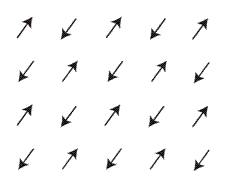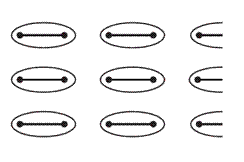Imaginary Time
Since spin components do not commute with each other in quantum mechanics, we cannot simply draw an “arrow” to represent a spin in general. This simple representation is, however, justifiable when we focus on a finite temperature phase transition because the quantum fluctuation is renormalized to zero. It is at zero temperature where the quantum nature of the system plays an essential role. role. There, we have another dimension called “imaginary time”.
Correspondence to Classical Systems
For example, let us consider an Ising model defined, as usual, with z-components of spins, and apply a transverse magnetic field in the x-direction. As we increase the field, we observe a phase transition from a ferromagnetic ordered state to a disordered state. In this critical phenomena, the scaling dimension of the imaginary time is 1, and the critical phenomena is essentially the same as that of the d+1 dimensional classical system, where d is the space dimension and +1 comes from the additional dimension of imaginary time. Although the imaginary time axis is equivalent to one of spatial dimensions in this example, it is not the case in general.

Condensation of Magnons
In the case of the S=1 Heisenberg spin model that we studied (Ref. “Quantum Monte Carlo Simulation of Heisenberg Model with Uni-axial Anisotropy“) , the scaling dimension of the imaginary time is not 1 and the quantum critical phenomena does not have a simple classical correspondence to d+1 dimensions. This phase transition is interpreted as condensation of magnons that obeys Bose-Einstein statistics.
Super-solid
In supersolid state, bose particles possesses crystalline order and superfluid order at the same time. The very existence of this state of matter in helium systems is still in debate. For lattice systems, on the other hand, it is relatively easy to demonstrate such states does exist. (Ref. “Supersolid of hardcore bosons on the face-centered cubic lattice“)
Tomonaga-Luttinger Liquid
Quantum spin systems shows various characteristic properties due to strong quantum fluctuation particularly in one dimension. For example, there are models in which a critical state appears in a finite area, not just at one point, of the phase diagram. In an S=1/2 Heisenberg model with a uni-axial spin anisotropy, we obtain such a quasi long-range-ordered state in a finite range of magnetic field. (Ref. “Exotic phase diagram at finite temperature in S=1/2 XXZ spin chains with weak interchain coupling“)
Deconfinement Critical Phenomena
Exotic phases characteristic to quantum systems is explored also in two dimensions. One example is a phase transition from a magnetically ordered state (Neel state) to a state with lattice rotation symmetry (VBS state). (Ref. “Emergent Spatial Structures in SU(N) Heisenberg Model“) In this phase transition, the symmetry group of neither phase is a subgroup of the other. Therefore, if it is of the second order, it is a phase transition of a new category. From the field theoretical studies, it is predicted that this phase transition is caused by deconfinement of spinons which are bound in either side of the transition.

Quantum Entanglement
Triggered by the discovery of potential usage as the powerful decipher machine, quantum computer and quantum entanglement have been actively discussed in recent years. Quantum spin models is simple and has been studied for many years, and they provide an ideal test-bed for theories of quantum information.(Ref. “Entanglement Entropy of Valence Bond Solid on Two-dimensional Lattice“)